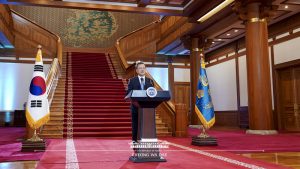In his annual New Year’s Address, South Korean President Moon Jae-in laid out what will likely be the last major components of his administration’s agenda before his term ends in May 2022. After a year that brought unexpected challenges from the COVID-19 pandemic, Moon framed his goals for 2021 as two simple objectives – recovery and resurgence.
While South Korea has generally been praised for its response to COVID-19, it has not been able to avoid all of the consequences of the pandemic. By the time Moon gave his New Years’ Address on January 11, nearly 70,000 South Koreans had been infected by COVID-19 and 1,165 had died.
There have been economic costs as well. Despite being able to keep the economy largely open through most of the pandemic, when final GDP numbers for 2020 are available the South Korean economy is expected to have declined by 1.1 percent. While that is projected to be the strongest performance among OECD countries, small businesses have taken the brunt of the economic damage along with workers. The decline in employment of 218,000 jobs for the year was the most significant since the Asian Financial Crisis in 1998.
Addressing the impact on daily life and the economic consequences from the pandemic are central to South Korea’s recovery in 2021. The first goal is a return to normal life. Moon has pledged to begin vaccinating South Koreans for free in February. To meet this goal South Korea has signed contracts with Pfizer, Johnson & Johnson, Moderna, and AstraZeneca to supply vaccines to inoculate the population. It will continue work on developing its own domestic vaccine and therapeutic drugs.
In parallel to South Korea’s vaccination efforts, the government is continuing to provide economic support to aid the economy in weathering the pandemic. Similar to other countries, South Korea has undertaken a series of supplemental budgets to support the economy. With small businesses, the self-employed, and others still in need of support, South Korea is preparing to expedite its budgetary spending in the first half of 2021 and to send a third round of stimulus payments to over 3.6 million microbusiness and individuals. It is also planning to support the creation of over 1 million new jobs.
But Moon’s agenda extends beyond the need for the economy to recover from the pandemic. Instead, he hopes to kick start an economic resurgence that will prepare the economy to succeed after the pandemic. These efforts began to take shape last year with announcement of the Korean New Deal. The Korean New Deal will move toward full implementation in 2021 and serve as centerpiece of Moon’s efforts to develop a Korean resurgence.
The Korean New Deal is centered around the pillars of the Green New Deal, the Digital New Deal, and the Regionally Balanced New Deal. The Green New Deal builds on earlier efforts by the Moon administration to develop hydrogen as a fuel source and will be a component in South Korean efforts to become carbon neutral by 2050. While the Green New Deal is designed to reduce carbon emissions and create jobs in environmentally friendly industries, the Digital New Deal is designed to provide South Korea with a foundation to compete internationally in the promising fields of 5G, AI, and big data. These two plans are complemented by the Regionally Balanced New Deal, which is designed to ensure that future economic development is better balanced around the country.
The economy is not the only focus for 2021. Moon hopes to build off of the popularity of music groups BTS and Blackpink, as well as the success of “Parasite” at the Academy Awards last year, to assist the creative arts in South Korea and enhance the country’s soft power.
North Korea, however, remains the major non-economic objective of the Moon administration. After helping to lay the groundwork for U.S. President Donald Trump’s summits with North Korean leader Kim Jong Un, Moon now faces the prospect of political change in the United States and North Korea’s efforts to deal with the pandemic undermining the prospects for progress in inter-Korean relations before his term ends. With the pandemic likely to remain North Korea’s focus in 2021, Moon called for inter-Korean cooperation on health care in two specific venues – the Northeast Asia Cooperation Initiative for Infectious Disease Control and Public Health and the initiative for comprehensive healthcare cooperation between South Korea-ASEAN.
Moon Jae-in came into office in the shadow of the Park Geun-hye impeachment, promising economic inclusion and better relations with North Korea. When he leaves office in May of 2022 much of his legacy will be shaped by how well his administration is able to manage South Korea’s economic recovery from COVID-19 and set the economy up to be globally competitive in the post-pandemic period. While North Korea and economic inclusion haven’t left the agenda, the pandemic will remain the priority.

































